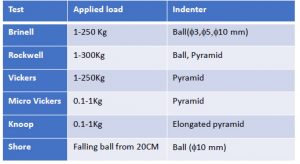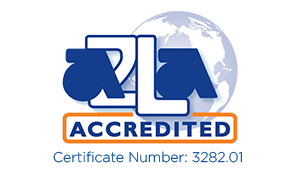Hardness Testing
Hardness testing measures hardness of a material, which is defined as resistance to penetration or resistance to deformation. The test involves indenting a prepared surface of materials by a spherical or pyramidal indenter under load for a fixed period like few seconds, then measure size and / or depth of the indentation made. The size and depth of indentation will vary as a function of hardness of the material, applied load and testing conditions lie temperature, etc. The test is simple to perform, does not require elaborate sample preparation and can be done directly on components if required. As a result, this test is a most commonly used testing method in production installation for product control.
Types of Hardness Testing
 There are several hardness testing methods. They can be classified in general as macro or micro hardness depending on the amount of applied load. Thus, if applied load is less than 1 Kg tests are generally called micro hardness. They are also classified as static and dynamic hardness testing. In a static hardness testing a load applied to the surface of materials through an indenter and maintained for few seconds until a permanent impression is made. In dynamic hardness measurements a ball is dropped from a fixed height. Rebound of the ball is measured as a measure of hardness. In addition, tests are also classified based on indenter type (ref table above). There are several tests related to standard hardness measurements. These are applied to coatings on the materials. Scratch hardness is a related testing where a scratch is made on the surface using a sharp needle and depth of the scratch is measured. Another related test is pencil hardness testing. For polymers and rubber, a special type of hardness called Durometer is used, in which an impresser is pressed on the flat specimen and the depth is measured as a measure of hardness. Majority of hardness testers are pedestal or bench top units. But several new hardness measurements based on the original concepts allow the testers to be portable. Typical examples are Barcol tester, Detroit hardness tester, TeleBrineller, etc. Many automated hardness measurement scanners are also available.
There are several hardness testing methods. They can be classified in general as macro or micro hardness depending on the amount of applied load. Thus, if applied load is less than 1 Kg tests are generally called micro hardness. They are also classified as static and dynamic hardness testing. In a static hardness testing a load applied to the surface of materials through an indenter and maintained for few seconds until a permanent impression is made. In dynamic hardness measurements a ball is dropped from a fixed height. Rebound of the ball is measured as a measure of hardness. In addition, tests are also classified based on indenter type (ref table above). There are several tests related to standard hardness measurements. These are applied to coatings on the materials. Scratch hardness is a related testing where a scratch is made on the surface using a sharp needle and depth of the scratch is measured. Another related test is pencil hardness testing. For polymers and rubber, a special type of hardness called Durometer is used, in which an impresser is pressed on the flat specimen and the depth is measured as a measure of hardness. Majority of hardness testers are pedestal or bench top units. But several new hardness measurements based on the original concepts allow the testers to be portable. Typical examples are Barcol tester, Detroit hardness tester, TeleBrineller, etc. Many automated hardness measurement scanners are also available.
Specimen Preparation and Geometry
The tests require simple sample preparation like cutting to standard shapes with flat surfaces like cubes, cylindrical coins, etc. The surface should be ground to certain roughness per ASTM or ISO standards. More often the tests may be run on production samples which may not be regular shapes. In all cases the axis of indentation should be maintained normal to the indenting surface as much as possible to get regular indentation.
Testing Conditions
Typically, hardness is measured at ambient conditions. Occasionally for certain applications such as power generation equipment, Hot working equipment, etc., hardness at high temperature may be required. Special hardness testing equipment are available to test at high temperature in vacuum or argon.
Capability – At TTL, we measure hardness of various metals, alloys, ceramic, polymers and composites as part of quality control support or research and development efforts for several aerospace, automotive and power generation equipment manufacturers routinely. We use the following range of equipment.
- Rockwell Hardness Tester
- Vickers Hardness Tester
- Micro Vickers Tester
- Durometer (A & D scale)
- Barcol Hardness Tester
- Detroit Hardness Tester
- Shore Hardness Tester
- TeleBrineller
- High Temperature Micro Vickers Tester
Some commonly used test standards:
- ASTM A956 – Standard test method for Equo tip hardness testing of steel products
- ASTM B277 – Standard test methods for hardness testing of electrical contact materials
- ASTM B294 – Standard test methods for hardness testing of cemented carbides
- ASTM D57 – Standard test methods for Microhardness of electroplated coatings
- ASTM B647 – Standard test method for indentation hardness of aluminum alloys by means of a Webster gage
- ASTM B721 – Standard test method for micro hardness and case depth testing of PM parts
- ASTM C661 – Standard test method for indentation hardness of elastomeric sealants by means of a Durometer
- ASTM C730 – Standard test method for Knoop indentation hardness of glass
- ASTM C748 – Standard test method for Rockwell Hardness of fine grained graphite
- ASTM C1326 – Standard test method for Knoop indentation hardness of advanced ceramics
- ASTM D785 – Standard test method for Rockwell hardness measurement of Electrical insulating materials
- ASTM D1475 – Standard test method for indentation hardness of organic coatings
- ASTM D2440 – Standard test method for Rubber property – Durometer hardness
- ASTM D2583 – Standard test method for indentation hardness of Rigid plastic by means ofBarcole impresser
- ASTM E10 – Standard test method for Brinell hardness of metallic materials
- ASTM E18 – Standard test methods for Rockwell hardness and Rockwell superficial hardness of metallic materials
- ASTM E92 – Standard test method for Vickers hardness of metallic materials
- ASTM E103 – Standard test method for rapid indentation hardness testing of metallic materials
- ASTM E140 – Standard hardness conversion table
- ASTM E384 – Standard test method for microhardness of materials
- ASTM F1957 – Standard test method for composite foam hardness- Durometer hardness



Touchstone is committed to providing its customers with quality, reliable test results. That is why we have undertaken the rigorous steps needed to meet and secure the most stringent of test lab accreditations including ISO/IEC 17025, NADCAP 7101 (Materials Test Lab) and NADCAP 7122-I (Non-Metallics Materials Testing).
© 2024, Touchstone Testing Labs | Design by Wheelhouse Creative

